| Address: | 115 East Lincoln, Mangum, Oklahoma | County | Greer |
| Started | November 1935 | Completed | March 1936 |
| NRHP: | Yes | NRHP Date: | April 4, 1994 |
| Agencies: | WPA |
Current Usage:
Not used.
Description:
The Mangum Armory (Mangum National Guard Armory) is a self-contained, horizontal, single-story building measuring 140 feet by 125 feet. A local project of the Works Progress Administration in Oklahoma, it was constructed in 1935-1937 of locally quarried native sandstone. The armory is located at 115 East Lincoln Street, in a primarily commercial area. The armory’s main entrance faces south. The floor plan of the Mangum Armory is typical of WPA built armories, in that the building comprises two distinct sections: A north section, with barrel roof, contains the drill area, while a flat-roofed south section comprises offices, supply and arms rooms, and a garage area. The square-cut ashlar blocks of sandstone of variegated light colors are set uncoursed, with beaded mortar joints. The masonry work is an excellent example of WPA architecture and construction philosophy in Oklahoma. Though the massing is strongly horizontal, several architectural details give the building a vertical emphasis and suggest a vernacular Art Deco influence; recessed stonework “incisions” in the front facade; projecting pilasters that rise into pedimented towers having recessed stonework “incisions”; and tall, vertical metal-frame windows. The windows are all original. Exterior alterations have been minimal: of three original wood overhead vehicle doors, one has been replaced with a metal door; of five exterior pedestrian doors, two have been replaced with steel doors. These very minimal changes do not affect the building’s integrity. The Mangum Armory retains more than adequate integrity of location, setting, design, workmanship, materials, feeling, and association sufficient to enable it to convey its past identity. It definitely embodies the distinctive characteristics of the WPA period and of WPA construction methodology.
WPA crews began clearing the armory site on November 1, 1935. The project’s supervisors estimated that it would employ forty men for three or four months, a gross underestimate of time. The blocks of sandstone were shaped on the site by the WPA crew. A short project expanded into a long one, but by November of 1936 the armory was nearly finished. A second WPA grant was obtained to complete interior work, which continued until March. On March 23, Mangum dedicated its new armory with an elaborate program. General Key, state WPA director, and other state and local dignitaries participated in the ceremonies, and program included a parade, a cornerstone ceremony, speeches, entertainment, and a dance in the new armory. Upon completion, the Mangum Armory became the home of Company H, a machine gun unit first mustered in June of 1935 as part of the 179th Infantry Regiment of the 45th Infantry Division, Oklahoma National Guard.^ Reorganized in 1923 under the National Defense Act of 1920, the Guard was an integral part of United States military preparedness. Since 1920 approximately five-sixths of America’s military strength lay with “citizen soldiers”—National Guard divisions and Reserve divisions in nine corps areas across the nation. Each corps area had one Regular Army division, two National Guard Divisions, and three Reserve divisions. Oklahoma, along with New Mexico, Arizona, and Colorado, formed one division of National Guard within the Eighth Corps. Despite inadequate training facilities, the Oklahoma National Guard provided service during numerous natural disasters and civil disturbances in the 1920s and 1930s. Because the Guard paid its members a monthly fee, which they spent locally to feed their families, Oklahoma communities actively competed to secure local Guard units during these years. In July of 1935 Mangum received an infantry unit. By 1937 the unit included three officers and sixty-two non-commissioned officers and enlisted men.
Entered into the National Register of Historic Places April 7, 1994.
Greer County commissioners submitted proposals for several WPA projects, one of which would be the construction of an armory. After the county deeded the old Greer County jail site on East Lincoln Street to the state in October, work began on November I. Earlier, during the autumn, a WPA crew had been at work near the community of Haystack, where stones for the armory and a new community center were being quarried. Thus, the sponsor’s share of the cost of the armory was provided in real property and materials. WPA crews began clearing the armory site on November 1, 1935. The project’s supervisors estimated that it would employ forty men for three or four months, a gross underestimate of time. The blocks of sandstone were shaped on the site by the WPA crew. A short project expanded into a long one, but by November of 1936 the armory was nearly finished. A second WPA grant was obtained to complete interior work, which continued until March. On March 23, Mangum dedicated its new armory with an elaborate program. General Key, state WPA director, and other state and local dignitaries participated in the ceremonies, and program included a parade, a cornerstone ceremony, speeches, entertainment, and a dance in the new armory. WPA projects in 1935-1937 propped up the sagging rural economy of Greer County, hard-hit because of the extended agricultural depression and severe drought. Major projects in Mangum included two large schools, a swimming pool, a community center, and the customary WPA road repair and paving. The WPA’s cost on the armory project was $41,649.71 (with the county contributing land and materials). With the exception of the farm-to-market road project and the community center building, the federal government invested more in the armory than in any other construction project in the county. In human terms, tens of thousands of person-hours of labor went into the armory’s construction. Most significantly, from thirty to forty men were employed on the project. As with most WPA projects, the armory project was labor-intensive, designed to provide as much work as possible for those on relief rolls. Most of the hours were consumed in hand labor stone cutting in the city’s quarry (22,000 cubic feet of stone were cut and hauled to the site), in dressing the blocks and hoisting them into place by hand, and in installing a maple-block floor in the drill room (148,000 wood blocks were cut, primed, set in asphalt, sanded, oiled, and polished, in sections). In the garage section, the floor was created of bricks set in sand. In both instances, a concrete floor would have sufficed, but ample time and labor were available to create a complicated design.
Upon completion, the Mangum Armory became the home of Company H, a machine gun unit first mustered in June of 1935 as part of the 179th Infantry Regiment of the 45th Infantry Division, Oklahoma National Guard. [1]
Sources:
- National Archives: National Register of Historic Places Registration Form.
- Department of Environmental Quality of Oklahoma
- Accomplishments of the Works Progress Administration for Oklahoma, July 1, 1935 to March 1, 1937
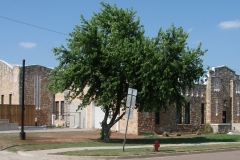
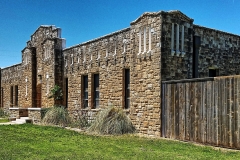
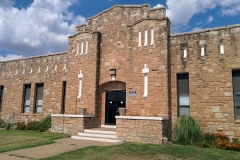
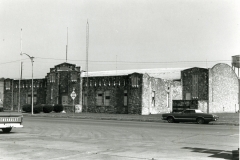
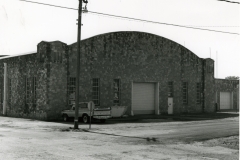
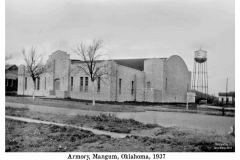



Leave a Reply